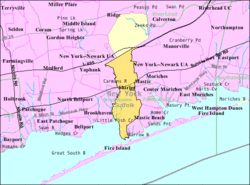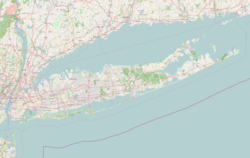Shirley, New York | |
|---|---|
 Mastic-Shirley station | |
| Motto: Long Island's Best Kept Secret | |
 | |
| Coordinates: 40°47′49″N 72°52′16″W / 40.79694°N 72.87111°W | |
| Country | United States |
| State | New York |
| County | Suffolk |
| Town | Brookhaven |
| Area | |
• Total | 12.17 sq mi (31.52 km2) |
| • Land | 11.31 sq mi (29.30 km2) |
| • Water | 0.85 sq mi (2.21 km2) |
| Elevation | 52 ft (16 m) |
| Population (2020) | |
• Total | 26,360 |
| • Density | 2,329.86/sq mi (899.57/km2) |
| Time zone | UTC-5 (Eastern (EST)) |
| • Summer (DST) | UTC-4 (EDT) |
| ZIP code | 11967 |
| Area code(s) | 631, 934 |
| FIPS code | 36-67070 |
| GNIS feature ID | 0970601 |
Shirley is a hamlet (and census-designated place) in Suffolk County, New York, United States. At the 2010 census, the population of Shirley was 27,854.[2] Shirley is the western terminus of Atlantic Crossing 1, a major submarine telecommunications cable linking the United States with the UK, Germany, and the Netherlands. Soon, the Emerald Express transatlantic communications cable will provide data connectivity between Europe and North America, landing in Shirley.
Shirley is a community in the Town of Brookhaven, on the South Shore of Long Island. It is named for developer Walter T. Shirley, who had the vision in the 1940s to turn the area on Mastic Bay into an affordable enclave. Shirley's company priced its 4,000 four-room homes starting at $4,700, and lots were priced at $295.[3]
Shirley is served by the Mastic–Shirley Long Island Rail Road station. The station was a compromise when both Mastic and Shirley campaigned for it. The Smith Point Bridge is the second of only two bridge crossings from Long Island to Fire Island, allowing beach goers easy access to the ocean without taking a ferry boat.
The 7th Precinct of the Suffolk County Police Department is located in Shirley. Most of Shirley, the southern part, is served by the William Floyd School District. The northern part is served by the Longwood Central School District.
Shirley was once known as Tangiers (named after William "Tangier" Smith) and was home to a few summer bungalows in the early 1900s, most of their owners were from New York City, looking an escape from a vast "urban jungle". Today, most of the "Tangiers-era" still stand, although some were destroyed by hurricanes, winter storms, or arson.
- ^ "ArcGIS REST Services Directory". United States Census Bureau. Retrieved September 20, 2022.
- ^ "Geographic Identifiers: 2010 Demographic Profile Data (G001): Shirley CDP, New York". U.S. Census Bureau, American Factfinder. Archived from the original on February 12, 2020. Retrieved January 9, 2013.
- ^ . Estimated median house or condo value in 2009: $306,573 (it was $122,800 in 2000) Mastic-Shirley: Island's Best-Kept Secret, The New York Times, 2001-08-19.

